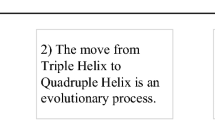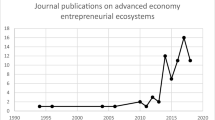Abstract
The application of stochastic processes in modeling uncertain phenomena will benefit researchers in the fields of various sciences like management, engineering, chemistry, physics, and business. The present article tries to apply several stochastic processes to modeling the relationship between entrepreneurial innovation and entrepreneurship. The Chinese restaurant process (CRP) and the Blackwell-MacQueen scheme are the processes that will be utilized to explore a predictive model. By presenting illustrative evidence, the CRP and the Blackwell-MacQueen scheme have helped us to understand how the Schumpeterian approach goes true. The study on the proposed equation demonstrated that the considered model also may signify levels of the decision in interpreting the nexus between innovation and entrepreneurship. Hence, a new function, arbitrary called “decision function,” was discovered and introduced in this study. After having reviewed the properties of the decision function, the relationship between entrepreneurship and entrepreneurial innovation (and also economic growth in its wake) was studied and interpreted. Regardless of mathematical models resulted from applying stochastic processes in investigating the relationship between entrepreneurship and innovation factors, the present paper reveals the importance of statistical models and stochastic processes in understanding the unmeasurable networks formed out of various factors.




Similar content being viewed by others
Data availability
The data are available on the official site of the World Intellectual Property Organization.
Notes
Linear, logarithmic, inverse, quadratic, cubic, compound, power, S, growth, exponential, logistic
A collection of simple and probability-based models, which is developed by considering colorful balls and several urns, that are widely used in other sciences such as economics, biology, medicine, engineering, etc.
Suppose G0(S) is a probability function that, in parametric or nonparametric manner, can present the characteristics of new business status of country. Furthermore, clearly, this function may be different in any country.
Herein, the Prior Density Function can be considered as the set of businesses that have not yet been launched in the area of interest.
According to the Global Entrepreneurship Monitor (GEM) annual research, in the factor-driven economies, most of the entrepreneurs prefer to get into a similar business whereas, in the innovation-driven economies, each entrepreneur by perceiving the business opportunities desires to venture into an innovative and low-competitive business.
The general definition of entrepreneurship by Global Entrepreneurship Monitor (GEM) is any business activity regardless of its ability to make money.
Abbreviations
- CRP:
-
Chinese restaurant process
- GEM:
-
Global Entrepreneurship Monitor
- GII:
-
Global Innovation Index
- TEA:
-
total early-stage entrepreneurial activities
- WEF:
-
World Economic Forum
- ERI:
-
Economic Resilience Index
References
Acha, V., & von Tunzelmann, G. N. (2004). Innovation in “low tech” industries. In J. Fagerberg, D. Mowery, & R. Nelson (Eds.), Oxford handbook of innovation Oxford; New York.
Acs, Z., & Storey, D. (2004). Introduction: Entrepreneurship and economic development.
Aldrich, D. P., & Meyer, M. A. (2014). Social capital and community resilience. The American Behavioral Scientist, 59, 254–269. https://doi.org/10.1177/0002764214550299.
Antoniak, C. (1974). Mixtures of Dirichlet processes with applications to Bayesian nonparametric problems. Ann. Statist., 2, 1152–1174.
Bahadur, A., & Doczi, J. (2016). Unlocking resilience through autonomous innovation. Working Paper, Overseas Development Institute, London.
Bai, D. S., & Chun, Y. R. (1993). Nonparametric inferences for ramp stress tests under random censoring. Reliability Engineering and System Safety, 3, 217–223.
Bai, D. S., & Lee, N. Y. (1996). Nonparametric estimation for accelerated life tests under intermittent inspection. Reliability Engineering and System Safety, 1, 53–58.
Basu, A. P., & Ebrahimi, N. (1982). Nonparametric accelerated life testing. IEEE Transactions on Reliability, 5, 432–435.
Baum, R. J., Frese, M., & Baron, R. (2007). The psychology of entrepreneurship. Lawrence Erlbaum Associates.
Bell, M., & Pavitt, K. (1993). Technological accumulation and industrial growth: Contrasts between developed and developing countries. Industrial and Corporate Change, 2, 157–210.
Blackwell, D., & MacQueen, J. B. (1973). Ferguson distributions via Ploya urn schemes. The Annals of Statistics, 2, 353–355.
Bristow, G., & Healy, A. (2018). Innovation and regional economic resilience: An exploratory analysis. The Annals of Regional Science, 60(2), 265–284.
Bullough, A., Renko, M., & Myatt, T. (2014). Danger zone entrepreneurs: The importance of resilience and self–efficacy for entrepreneurial intentions. Entrepreneurship Theory and Practice, 38(3), 473–499. https://doi.org/10.1111/etap.12006.
Butz, T. N., Hanson, S., Schultz, P., & Warzynski, M. M. (2018). Beyond the big five: Does grit influence the entrepreneurial intent of university students in the US? Journal of Global Entrepreneurship Research, 8, Article number: 15.
Capello, R., Caraglui, A., & Fratesi, U. (2015). Spatial heterogeneity in the costs of the economic crisis in Europe: Are cities sources of regional resilience? Journal of Economic Geography, 15, 951–972. https://doi.org/10.1093/jeg/lbu053.
Cheng, N., & Yuan, T. (2013). Nonparametric Bayesian lifetime data analysis using the Dirichlet process lognormal mixture model. Naval Research Logistics, 3, 208–221.
Chrisman, J. J., Hynes, T., & Fraser, S. (1995). Faculty entrepreneurship and economic development: The case of the University of Calgary. Journal of Business Venturing, 10(4), 267–281.
Coccia, M. (2010). Democratization is the driving force for technological and economic change. Technological Forecasting and Social Change, 77(2), 248–264. https://doi.org/10.1016/j.techfor.2009.06.007.
Coccia, M. (2014). Socio-cultural origins of the patterns of technological innovation: What are the likely interaction among religious culture, religious plurality, and innovation? Towards a theory of socio-cultural drivers of the patterns of technological innovation. Technology in Society, 36(1), 13–25. https://doi.org/10.1016/j.techsoc.2013.11.002.
Coccia, M. (2014b). Religious culture, democratization, and patterns of technological innovation. International Journal of Sustainable Society, 6(4), 397–418. https://doi.org/10.1504/IJSSOC.2014.066771.
Coccia, M. (2017). A theory of general causes of violent crime: Homicides, income inequality and deficiencies of the heat hypothesis and of the model of CLASH, Aggression and Violent Behavior, vol. 37, November-December, pp. 190–200, https://doi.org/10.1016/j.avb.2017.10.005.
Coccia, M. (2019). Theory of development. In A. Farazmand (Ed.), Global encyclopedia of public administration, public policy, and governance. https://doi.org/10.1007/978-3-319-31816-5_939-1.
Cooke, P., & Eriksson, A. (2011). White spaces innovation in Sweden: Innovation policy for exploring the adjacent possible. Sweden: VINNOVA.
Crudu, R. (2019). The role of innovative entrepreneurship in the economic development of EU member countries, Journal of ENTREPRENEURSHIP, MANAGEMENT and INNOVATION DOI: https://doi.org/10.7341/20191512 JEL codes: O10, O11, O30, O52.
Davies, S. (2011). Regional resilience in the 2008–2010 downturn: Comparative evidence from European countries. Cambridge Journal of Regions, Economy and Society, 4(3), 369–382.
Diodato, D., & Weterings, A. B. R. (2014). The resilience of regional labor markets to economic shocks: Exploring the role of interactions among firms and workers. Journal of Economic Geography, 15(4), 723–742.
Edward, J. M. (2018). Entrepreneurs, networks, and economic development: A review of recent research. In J. A. Katz & A. C. Corbett (Eds.), Reflections and extensions on key papers of the first twenty-five years of advances (Advances in Entrepreneurship, Firm Emergence and Growth, Volume 20) (pp. 71–116). Emerald Publishing Limited.
Escobar, M. D. (1994). Estimating normal means with a Dirichlet process prior. Journal of the American Statistical Association, 425, 268–277.
Escobar, M. D., & West, M. (1995). Bayesian density estimation and inference using mixtures. Journal of the American Statistical Association, 430, 577–588.
Evans, M., & Swartz, T. (1995). Methods for approximating integrals in statistics with special emphasis on Bayesian integration problems. Statistical Science, 10, 254–272.
Fagerberg, J. (2003). Schumpeter and the revival of evolutionary economics: An appraisal of the literature. Journal of Evolutionary Economics, 13, 125–159.
Fagerberg, J., Mowery, D., & Nelson, R. (2004). The Oxford handbook of innovation. Oxford: Oxford University Press.
Faggian, A., Gemmiti, R., Jaquet, T., & Santini, I. (2018). Regional economic resilience: the experience of the Italian local labor systems. The Annals of Regional Science, Volume 60, Number 2, Page 393.
Faghih, N., Bonyadi, E., & Sarreshtehdari, L. (2019). Global entrepreneurship capacity and entrepreneurial attitude indexing based on the global entrepreneurship monitor (GEM) dataset, globalization and development, pp 13–55.
Ferguson, T. S. (1973). A Bayesian analysis of some nonparametric problems. The Ann. Statist, 1, 209–230.
Fuentelsaz, L. P., Maicas, J., & Montero, J. (2018). Entrepreneurs and innovation: The contingent role of institutional factors. Small Business Journal: Researching Entrepreneurship2018, 36(6), 686–711.
Gerguri, S. H., & Ramadani, V. (2010). “The impact of innovation into the economic growth” Munich Personal RePEc Archive (MPRA), No. 22270.
Gerschenkron, A. (1962). Economic backwardness in historical perspective, Cambridge (Mass.). The Belknap Press.
Granstrand, O. (2004). Innovation and intellectual property rights. In J. Fagerberg, D. Mowery, & R. Nelson (Eds.), The Oxford handbook of innovation (pp. 266–290). Oxford University Press.
Griffith, R., Huergo, E., Mairesse, J., & Peters, B. (2006). Innovation and productivity across four European countries. Oxford Review of Economic Policy, 22, 483–498.
Grossman, G. M., & Helpman, E. (1991). Innovation and growth in the global economy. MIT Press.
Harper, D. A. (2003). Foundations of entrepreneurship and economic development. Routledge.
Hobday, M. (1995). East Asian latecomer firms. World Development, 23, 1171–1193.
Ignatove, A. (2019). Entrepreneurial innovation key to a sustanable and competitive European Union, Augustin ignatov,Academy of Economic Studies of Moldova, Volume 12 .
Kline, S. J., & Rosenberg, N. (1986). An overview of innovation. In R. Landau & N. Rosenberg (Eds.), The positive sum strategy: Harnessing Technology for Economic Growth (pp. 275–304). Washington D.C.: National Academy Press.
Leff, N. H. (1979). Entrepreneurship and economic development: The problem revisited. Journal of Economic Literature, 17(1), 46–64.
Lounsbury, M., Cornelissen, J., Granqvist, N., & Grodal, S. (2019). Culture, innovation and entrepreneurship, innovation (Vol. 21, NO. 1, 1–12). Routledge Taylor & Francis group. https://doi.org/10.1080/14479338.2018.1537716.
Markides, C. (2006). Disruptive innovation: In need of better theory. Journal of Product Innovation Management, 23(1), 19–25.
Müller, P., & Quintana, F. A. (2004). Nonparametric Bayesian data anal-ysis. Statistical Science, 1, 95–110.
Nafziger, E. W. (2005). Theories of economic development. In Economic development (pp. 123–164). https://doi.org/10.1017/CBO9780511805615.006.
Naudé, W. (2008). Entrepreneurship in economic development (no. 2008/20). WIDER Research Paper.
Polin, B., & Golla, S. (2016). “Entrepreneurship in developed and developing nations: Contrasting the entrepreneurs and their contributions,” Proceedings of International Academic Conferences, 3305685.
Ray, G. F. (1980). Innovation as the source of long term economic growth. Long Range Planning, 13.
Schumpeter, J. A. (1934). The theory of economic development: An inquiry into profits, capital, credit, interest, and the business cycle. Cambridge, MA: Harvard University Press.
Stephanie, D. S., Raetze, S., & Scheuch, I. (2019). The role of diversity in organizational resilience: A theoretical framework. Business Research, 1–37.
Todaro, M. P., & Smith, S. C. (2003). Economic development. Harlow: Parson Addison Wesley.
Tomma, S., Grigorea, A., & Marinescu, P. (2014). Economic development and entrepreneurship. Procedia Economics and Finance, 8, 436–443.
World bank report, BRIEF, Innovation & Entrepreneurship, July 8, 2015.
Yeager, T. (2018). “Institutions, Transition Economies, and Economic Development”. 1st Edition 1999, Politics & international relations, eBook ISBN: 9780429499760, pp 184: https://doi.org/10.4324/9780429499760.
Acknowledgments
We are grateful to the reviewers for their wonderful comments and suggestions throughout the review process as well as do thank Mr. Moein Heydary for his endeavors in editing this paper. Additionally, we highly wish to thank our parents and family for inspiriting us during this research.
Author information
Authors and Affiliations
Contributions
Nezameddin Faghih: The main ideas behind the paper have been developed by him and also he acted as the supervisor trying to improve the structures of this article. Ebrahim Bonyadi: conceptualization, methodology, software (including R programing language, and SPSS), validation, formal analysis, data curation, writing—original draft, writing—review and editing, supervision, project administration. Lida Sarreshtehdari: investigation, resources, formal analysis, writing—original draft, visualization, project administration.
Corresponding author
Ethics declarations
Competing interests
The authors declare that they have no competing interests.
Rights and permissions
About this article
Cite this article
Faghih, N., Bonyadi, E. & Sarreshtehdari, L. On the utility of the stochastic processes in modeling the nexus between entrepreneurship and innovation: a nonparametric application of Bayesian inference. J Glob Entrepr Res 11, 97–111 (2021). https://doi.org/10.1007/s40497-021-00272-3
Received:
Accepted:
Published:
Issue Date:
DOI: https://doi.org/10.1007/s40497-021-00272-3




